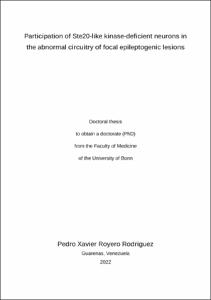Participation of Ste20-like kinase-deficient neurons in the abnormal circuitry of focal epileptogenic lesions

Participation of Ste20-like kinase-deficient neurons in the abnormal circuitry of focal epileptogenic lesions

| dc.contributor.advisor | Beck, Heinz | |
| dc.contributor.author | Royero Rodriguez, Pedro Xavier | |
| dc.date.accessioned | 2022-01-03T11:19:49Z | |
| dc.date.available | 2022-01-03T11:19:49Z | |
| dc.date.issued | 03.01.2022 | |
| dc.identifier.uri | https://hdl.handle.net/20.500.11811/9525 | |
| dc.description.abstract | Focal epileptogenic lesions displaying morphologically altered neurons are frequently associated with devastating and therapy-refractory epilepsies. However, it is still unsolved how dysplastic neurons contribute to the striking increase in the propensity to generate seizures. In this study, we aimed to better understand the functional connectivity features at the microcircuit level of morphological-altered neurons within cortical networks. To this end, we used a newly generated model of dysplastic neurons that mimics the reduced expression of the Ste20-like kinase (SLK) as found in dysmorphic cellular elements from human cortical malformations. Loss of SLK strongly impairs dendritic and inhibitory synapse formation and leads to an aggravated phenotype of chemically-induced seizures. We demonstrated that the downregulation of SLK in cortical neurons causes a selective, cell-autonomous loss of synaptic inhibition accompanied by a shift in the excitation/inhibition (E/I) balance. Using optogenetic approaches we found that the inhibition impairment of SLK-deficient neurons is confined to feedforward inhibitory circuits, and does not affect feedback or lateral inhibition. Interestingly, SLK loss specifically reduced inhibition mediated by PV-expressing interneurons, but not by somatostatin-expressing interneurons. This deficit led to increased activity levels of SLK-deficient neurons in intact mice. Finally, to assess the specific connection between the E/I imbalance and the transcriptional changes triggered by the loss of SLK, we performed patch-clamp RNA sequencing. This yielded several differentially expressed candidate genes, as well as genes correlated with the affected functional properties of cortical neurons. These results point to the downregulation of SLK as a key factor contributing to the E/I imbalance observed within focal epileptogenic lesions featuring dysplastic neurons. Moreover, our results suggest a relevant and cell-autonomous role for SLK in mechanisms governing inhibitory synapse specificity. | en |
| dc.language.iso | eng | |
| dc.rights | In Copyright | |
| dc.rights.uri | http://rightsstatements.org/vocab/InC/1.0/ | |
| dc.subject | Dysplastic neurons | |
| dc.subject | Focal epileptogenic lesions | |
| dc.subject | Feed-forward inhibition | |
| dc.subject | Ste20-like kinase | |
| dc.subject | cortical pyramidal neuron | |
| dc.subject | patch-clamp RNA sequencing | |
| dc.subject | Parvalbumin interneuron | |
| dc.subject.ddc | 500 Naturwissenschaften | |
| dc.subject.ddc | 570 Biowissenschaften, Biologie | |
| dc.subject.ddc | 610 Medizin, Gesundheit | |
| dc.title | Participation of Ste20-like kinase-deficient neurons in the abnormal circuitry of focal epileptogenic lesions | |
| dc.type | Dissertation oder Habilitation | |
| dc.publisher.name | Universitäts- und Landesbibliothek Bonn | |
| dc.publisher.location | Bonn | |
| dc.rights.accessRights | openAccess | |
| dc.identifier.urn | https://nbn-resolving.org/urn:nbn:de:hbz:5-64985 | |
| ulbbn.pubtype | Erstveröffentlichung | |
| ulbbnediss.affiliation.name | Rheinische Friedrich-Wilhelms-Universität Bonn | |
| ulbbnediss.affiliation.location | Bonn | |
| ulbbnediss.thesis.level | Dissertation | |
| ulbbnediss.dissID | 6498 | |
| ulbbnediss.date.accepted | 21.12.2021 | |
| ulbbnediss.institute | Medizinische Fakultät / Institute : Institut für Experimentelle Epileptologie und Kognitionswissenschaften | |
| ulbbnediss.fakultaet | Medizinische Fakultät | |
| dc.contributor.coReferee | Isbrandt, Dirk | |
| ulbbnediss.contributor.gnd | 1252096860 |
Files in this item
This item appears in the following Collection(s)
-
E-Dissertationen (2079)




